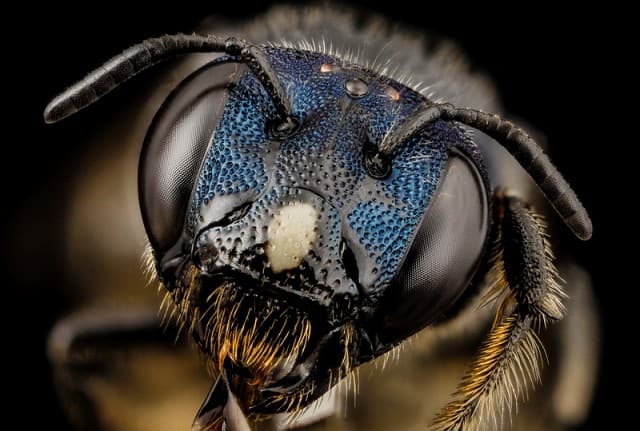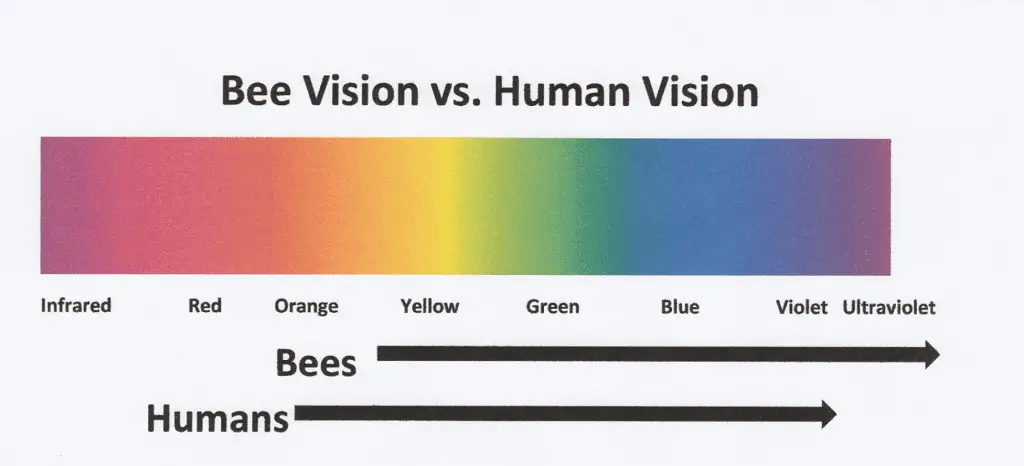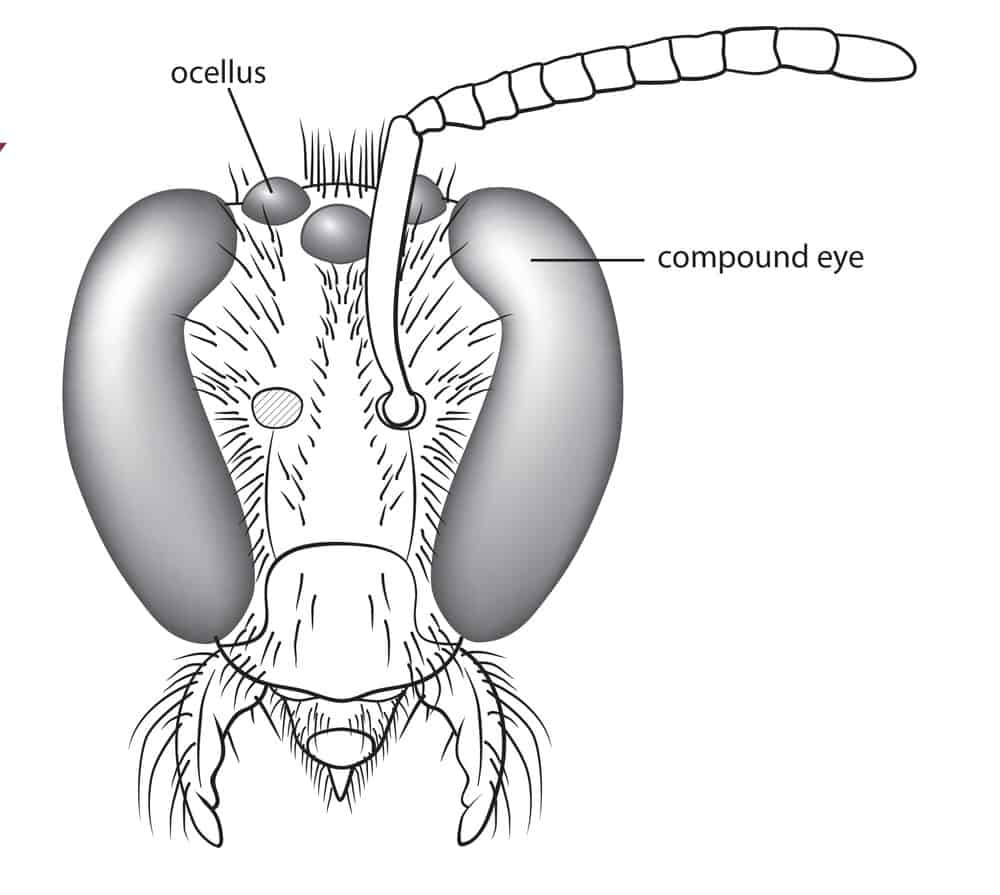Most species of bees have five eyes. Bees typically have two compound eyes, which sit on the sides of its head, as well as three ocelli, which sit on their forehead in a small triangle shape.
It is easy to miss ocelli when looking at a bee’s head because they are so tiny, and they are not where you might expect a bee’s eyes to be. However, they are very important for a bee’s navigation and defense against predators. Read on to learn more about bee eyes!
Why Does a Bee Have Five Eyes?

Bees have two different types of eyes, compound eyes and ocelli. These types of eyes serve different purposes for bees. Compound eyes detect patterns and colors, while ocelli detect light but not shapes or patterns. In the image above, the two large black eyes on the sides of the face are the compound eyes, while the tiny round eyes that look like pinheads are the ocilli.
Compound eyes are used to find flowers for foraging and see landmarks that will lead the bee back to their nest. Compound eyes are more similar to human eyes than ocelli.
Ocelli detect only light changes and not shapes or patterns, meaning that they are primarily used to tell a bee if a predator is casting a shadow on them, alerting them to danger. The word “ocelli” means “simple eye.”
How do Bee Eyes Work?
Bees’ eyes are similar to human eyes in that bees are trichromatic, meaning that they have three photoreceptors in their eyes that combine to create all the colors that they can see. However, while humans see color as combinations of blue, red, and green, bees see color as combinations of ultraviolet, blue, and green. This means that bees do not see the color red at all.

As shown in the picture above, bees’ vision ability extends into the ultraviolet part of the color spectrum, and ends around the yellow part of the spectrum. Because bees see mostly in the blue, violet, and ultraviolet parts of the spectrum, flowers that include these colors are most attractive to them. Here is a link to a video showing what vision looks like to bees.
Bees can also see color much faster than humans, which might be a confusing concept at first. But picture a group of flowers all moving in the wind. While you might have trouble following a single flower within that group, a bee will have no problem zoning in on that specific flower and landing on it quickly.
Because of their quick color sight, bees see better in flight than when they are stationary. This is why they hover around flowers before choosing one to land on.
Do Different Bees Have Different Kinds of Eyes?
Yes, different bees have different kinds of eyes. In fact, bee eyes differ between sexes in many species, including the stingless bee and the honey bee. The eyes of male bees of these species have larger surface areas than those of females.
Additionally, bee eyes vary between species. While stingless bees have smooth, shiny eyes, honey bees actually have tiny hairs all over their eyes! This hair helps them navigate when it is windy, catching the air and letting them know what direction the wind is moving.
On top of that, some bees have eyes that allow them to see in the night time. Megalopta genalis bees forage only right before sunrise and right after sunset, making them nocturnal. This species accomplishes this by having very large compound eyes and larger lenses within these eyes.
Additionally, different bee species have different sized eyes depending on their head size and overall body size. Bigger bees typically have much larger eyes than those of smaller bees.
What are Compound Eyes?

Bees’ compound eyes are the bigger, more noticeable eyes on the sides of their heads above their cheeks. When we think of bees’ eyes, these are the eyes that we typically imagine.
Bees’ compound eyes are made up of thousands of little individual lenses. Bees can have from 1,000 to 16,000 lenses depending on their species. These lenses can detect not only regular light, but also polarized light, which moves in one single direction as air molecules move photons around. Bees follow the trails of this polarized light to navigate their world, flying between flowers and their nest.
Bees’ two compound eyes are quite different from human eyes, meaning that bees see the world entirely differently from the way that we do. Bees can only see details up close with their compound eyes, meaning that from far away, flowers are just blobs of color. But once they are up close, they can see all the details of a flower with their compound eyes.
Compound eyes are not well-suited for night vision, but despite this, there are species of bees that forage nocturnally. For example, the species Xylocopa tranquebarica does its foraging at night. Its eyes have adapted for vision in low light situations, being larger than those of other bees.
Honey bees, or Apis mellifera, have photoreceptors that can detect UV light, blue, and green colors. They are colorblind at night and therefore forage during the day, basing their foraging activities on the colors of flowers. However, the above-mentioned species, X. tranquebarica, can see colors at night.
Because bees can detect ultraviolet light, they have much more accurate eyes than humans when it comes to flowers. Each flower has ultraviolet patterns on its surface that attract bees and help them differentiate between their preferred species of flowers.
What are Ocelli?
Ocelli are typically arranged in a triangle at the top of the bees’ head, above and between their compound eyes. These eyes are much smaller, looking like the head of a pin resting on the bee’s forehead.
Ocelli are very simple eyes, containing just one lens in each eye. These eyes determine the intensity of light, meaning that if a predator approaches a bee from above, their ocelli will detect their shadow and alert them to the presence of the predator.
Ocelli are also used to detect ultraviolet rays, which helps the bee orient itself in relation to the sun. While ocelli only have one lens, that single lens is much more sensitive than that of a lens within a compound eye, meaning that the small size of these eyes does not diminish their usefulness.
What Other Types of Insects Have Five Eyes?
It isn’t just bees who have five eyes! Many other types of insects, including dragonflies, wasps, and grasshoppers also have this system of combined compound eyes and ocelli.
In Conclusion
As you can see from this article, bee eyes are quite surprising and interesting. Their five eyes serve a multitude of functions for bees, including foraging, navigation, and predator detection. They have two large compound eyes on the sides of their heads as well as three ocilli, or simple eyes, on their foreheads.
Bees are capable of seeing both ultraviolet light and polarized light, which helps them navigate in relation to the sun and find flowers from which to gather nectar and pollen. While their compound eyes have thousands upon thousands of lenses, their simple eyes just have one lens per eye. These simple eyes detect only changes in light, and not the patterns and colors that their compound eyes are capable of seeing.

